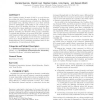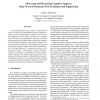3792 search results - page 55 / 759 » Techniques for Trusted Software Engineering |
CASES
2010
ACM
13 years 7 months ago
2010
ACM
3-D circuit-level integration is a chip fabrication technique in which two or more dies are stacked and combined into a single circuit through the use of vertical electroconductiv...
CBSE
2008
Springer
13 years 12 months ago
2008
Springer
Abstract. Automata-based interface and protocol specifications provide an elegant framework to capture and automatically verify the interactive behavior of component-based software...
SAC
2006
ACM
14 years 3 months ago
2006
ACM
The Coalition Peering Domain (CPD) is a recent innovation within the field of mesh networking. It facilitates the management of community-area networks in a distributed and scala...
IWPC
2003
IEEE
14 years 3 months ago
2003
IEEE
A key desideratum for many software comprehension tools is to reduce the mental burdens of software engineers. That is, the tools should support cognition. This key benefit is di...
FPL
2005
Springer
14 years 3 months ago
2005
Springer
Stream ciphers are a promising technique for encryption in trusted hardware. ISO/IEC standardization is currently under way and SNOW 2.0 is one of the remaining candidates. Its sof...


